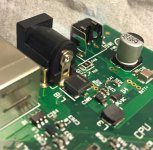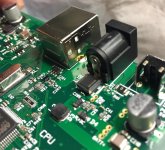Hello,
A friend of mine damaged his synthesizer by using the wrong power supply. Would anyone be able to help Identify what the black component is, where it labeled L20, next to the connector? I am hoping its a set of diodes used to protect the circuit. I dont have the circuit with me, and the photos are from the internet.
Thanks

A friend of mine damaged his synthesizer by using the wrong power supply. Would anyone be able to help Identify what the black component is, where it labeled L20, next to the connector? I am hoping its a set of diodes used to protect the circuit. I dont have the circuit with me, and the photos are from the internet.
Thanks
If it has four terminals (I think it does, but it is hard to see on the photo), probably a common-mode inductor, that is, two magnetically coupled inductors used for interference suppression.
L20 indicates an inductor indeed, as pointed out by #2 & #3.
If four terminals, MarcelvdG is very close.
The small cap C (?) 13 makes it a noise filter.
Measure all the terminals, one of the inductors can be broken (oddly the ground one most often!); a bridge can get things working agein.
If four terminals, MarcelvdG is very close.
The small cap C (?) 13 makes it a noise filter.
Measure all the terminals, one of the inductors can be broken (oddly the ground one most often!); a bridge can get things working agein.
These are from his actual machine. with the meter set to 2K resistance, .280 for green to green and .025 for red to red. Green to red .268

Attachments
It is an inductor, and only the right hand side pads are used from green top right to red bottom right. From there the supply is routed to elsewhere through the via's.
Hard to tell by your photo, but is this a crispy critter on the board?

Maybe just an inductor, but hard to tell on the photo.
What synth is this?
Maybe just an inductor, but hard to tell on the photo.
What synth is this?
Thanks for discovering that. I think he said it is a Novation and the model is Circuit. He is trying to find if, hopefully, a replaceable component is what got damaged, so your findings will bring optimism.
Thank you all for generously sharing your knowledge and expertise. I am rodrigosalvati's friend, now joining the community to learn from you and try to extend the life of electronic things here and there. Thanks to you all, I am now getting closer to (hopefully!) repairing my beloved groovebox/synth (Novation Circuit (OG. c.a. 2010).
Avtech recently pointed this guy as the possible toasted one. Would you say he's roasted? (the component, I mean!). I've noticed that none of the elements in the board sport such a tan. It is tiny and very hard to accurately test with the multimeter (I need to get myself a magnifying glass!). That said, it shows continuity (the multimeter beeps when I place the probes in opposite metallic ends). What is it? a resistor? Do you think it can be replaced?
Thank you all in advance for your kind support!

Avtech recently pointed this guy as the possible toasted one. Would you say he's roasted? (the component, I mean!). I've noticed that none of the elements in the board sport such a tan. It is tiny and very hard to accurately test with the multimeter (I need to get myself a magnifying glass!). That said, it shows continuity (the multimeter beeps when I place the probes in opposite metallic ends). What is it? a resistor? Do you think it can be replaced?
Thank you all in advance for your kind support!
Last edited:
Looks to be an inductor with a black plastic coating, so it's fine.Avtech recently pointed this guy as the possible toasted one. Would you say he's roasted? (the component, I mean!). I've noticed that none of the elements in the board sport such a tan. It is tiny and very hard to accurately test with the multimeter (I need to get myself a magnifying glass!). That said, it shows continuity (the multimeter beeps when I place the probes in opposite metallic ends). What is it? a resistor? Do you think it can be replaced?
Does this one have the option to be powered by batteries? If so, does it work on batteries?
In recent years, I've repaired several pieces of equipment which had these noise supressing inductors in the supply entrance. Most often, if not all, the ground inductor broke (curious, as the currnet flowing in and out is the same!). A wire bypass brought the 1K+ ($/€) device back to life again. Unreliable and way to cheap engineerd to avoid solid but expensive emc testings.
Dear comrades:
Thank you all for your incredible generosity sharing your knowledge and experience. After trying all of the strategies you proposed with no results, I was able to find a replacement board at a reasonable price. I ended up transplanting it into my old synth and it came back to life!
Now that I have wiped the sweat from my forehead and reclined back in the chair, it becomes important for me to note that it's not that the strategies you provided me with were useless, but rather, that I still have so much to learn! I'm starting by closely comparing both boards: wish me patience!
Thank you all for your incredible generosity sharing your knowledge and experience. After trying all of the strategies you proposed with no results, I was able to find a replacement board at a reasonable price. I ended up transplanting it into my old synth and it came back to life!
Now that I have wiped the sweat from my forehead and reclined back in the chair, it becomes important for me to note that it's not that the strategies you provided me with were useless, but rather, that I still have so much to learn! I'm starting by closely comparing both boards: wish me patience!
- Home
- Design & Build
- Parts
- Help Identifying component



